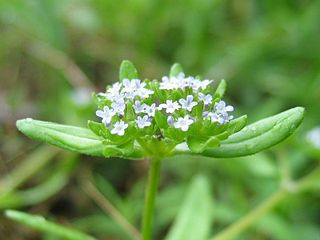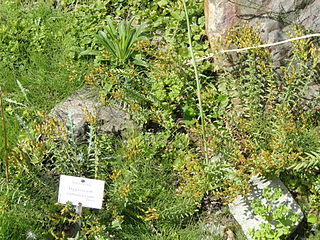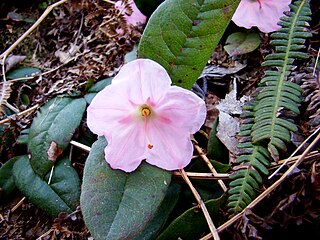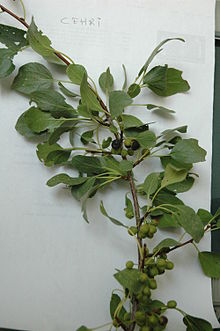
Lolium persicum is a species of flowering plant in the family Poaceae. It is referred to by the common names Persian darnel or Persian ryegrass, and is an annual grass. It has an upright stem, branching from a reddish base, up to 45 cm tall. Its leaves are lower surface glossy, dark green, 6 mm wide.

Isatis is a genus of flowering plants in the family Brassicaceae, native to the Mediterranean region east to central Asia. The genus includes woad. Due to their extremely variable morphology, the Asian species in particular are difficult to determine; the only reliable diagnostic feature is the ripe fruit. They are (usually) biennial or perennial herbaceous plants, often bluish and hairless or downy hairy with the upright stem branched.

Alyssum is a genus of about 100–170 species of flowering plants in the family Brassicaceae, native to Europe, Asia, and northern Africa, with the highest species diversity in the Mediterranean region. The genus comprises annual and perennial herbaceous plants or (rarely) small shrubs, growing to 10–100 cm tall, with oblong-oval leaves. Alyssum flowers are characteristically small and grouped in terminal clusters; they are often yellow or white colored but can be pink or purple.

Agrostis nebulosa is a species of flowering plant in the family Poaceae. It is referred to by the common name cloud grass, and is an ornamental plant native to Morocco, Portugal and Spain. This plant is often cultivated for its light delicate heads that are used dried in floristry.

Helleborus cyclophyllus is a flowering perennial plant in the family Ranunculaceae. It is native to Albania, Bulgaria, Greece, and Yugoslavia. It is similar in appearance to other hellebores found in the Balkan region. It is acaulescent, meaning it lacks a stem with leaves, instead sending up a leafless flower stalk. The green leaves are palmate and basal, spreading at the ground. The flowers are green to yellow-green and 2 to 3 inches in diameter.

Valerianella is a genus of plant in family Caprifoliaceae. Many plants of this genus are known by the common name corn salad or cornsalad, although that name most often refers to Valerianella locusta.
Salvia taraxacifolia is a species of flowering plant in the Lamiaceae family. It is referred to by the common name Dandelion leaved sage and is a herbaceous perennial shrub that is endemic to southwest Morocco, growing in the Atlas Mountains at elevations ranging from 2,000 feet (610 m) to 8,000 feet (2,400 m). Very adaptable, it grows on limestone slopes, forest clearings, and rocky riversides. It has no close allies in the genus Salvia. The specific epithet, taraxacifolia, is likely Persian in origin and means 'leaves shaped like a dandelion'.

Ventenata is a genus of plants in the grass family, native to Europe, North Africa, and central + southwest Asia. One species, Ventenata dubia, is considered an invasive weed in many places.

Cyclamen africanum is a species of flowering plant in the family Primulaceae. It is referred to by the common name African cyclamen and is a perennial growing from a tuber, native to northern Algeria, Morocco and Tunisia. It is similar to Cyclamen hederifolium, but not frost-hardy.
Salvia microstegia is a herbaceous perennial plant in the family Lamiaceae. It is native to Israel, growing on Mount Hermon. The plant has white or pale violet flowers, blooming from June to September.

Hypericum rumeliacum is a species of flowering plant in the family Hypericaceae, native to southeastern Europe.

Rhamnus libanotica is a species of flowering plant in the Rhamnaceae family. It is referred to by the common name Lebanese buckthorn, and is native to Western Asia from Lebanon and Syria to Turkey.
Helicia petiolaris is a plant in the family Proteaceae. The specific epithet petiolaris means "stalked", referring to the leaves.
Bukiniczia cabulica is a plant in the plumbago or leadwort family, Plumbaginaceae. It is the sole species in the monotypic genus Bukiniczia. It is a biennial native to Afghanistan and Pakistan. It forms a basal rosette of leathery leaves, growing a stem with pink flowers in its second year.
Rhamnus persica is a species of plant in the family Rhamnaceae.

Crocus hyemalis is a species of flowering plant in the family Iridaceae. It is referred to by the common name winter saffron and is native to Lebanon, the Palestine region and Syria.
Hypericum pubescens is a perennial herb in the Hypericaceae family. It is in the section Adenosepalum.
Tordylium elegans is a species of flowering plants in the family Apiaceae. It is endemic to Turkey.

Epigaea gaultherioides is a species of flowering plant in the Ericaceae family. It is native to Transcaucasia and Turkey.
Campanula lazica is a species of flowering plant in the bellflower family, Campanulaceae. It is endemic to northeast Anatolia, Turkey.












